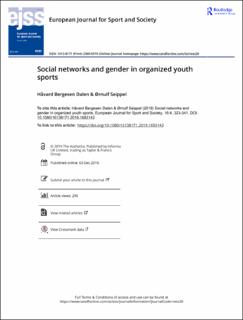Social networks and gender in organized youth sports
Peer reviewed, Journal article
Published version
Permanent lenke
https://hdl.handle.net/11250/2653714Utgivelsesdato
2019Metadata
Vis full innførselSamlinger
- Artikler / Articles [2119]
- Publikasjoner fra Cristin [1107]
Originalversjon
European Journal for Sport and Society. 2019, 16(4), 323-341. 10.1080/16138171.2019.1693143Sammendrag
Sports are social, and the sociability of sports (e.g. individual experiences, group cohesion or generalised social trust) and its consequences (e.g. enjoyment, inclusion, or social capital) depends on the social networks in sports teams. In this study we investigate various types of social networks in sports—strong and weak—for boys and girls. We look at the number of social relations in each team (average degree), how centralised and hierarchical teams are, and how each team clusters and consists of subgroups. We hypothesise that: (i) Boys’ and girls’ teams differ in number of social relations, (ii) Boys’ social networks are more hierarchical than girls’ networks, and (iii) Girls’ teams are more clustered than boys’ teams. Network data from 387 adolescent athletes on 30 sports teams in football, handball, cross-country skiing and biathlon were collected with an electronic survey-questionnaire. The results reveal large differences in network structures between teams. We find that the total number of social relations is higher in girls’ teams, that there are small gender differences with respect to networks' hierarchies, and that girls’ networks cluster more than boys’ networks.
Beskrivelse
This is an Open Access article distributed under the terms of the Creative Commons Attribution-NonCommercial-NoDerivatives
License (http://creativecommons.org/licenses/by-nc-nd/4.0/), which permits non-commercial re-use, distribution, and reproduction in
any medium, provided the original work is properly cited, and is not altered, transformed, or built upon in any way.
